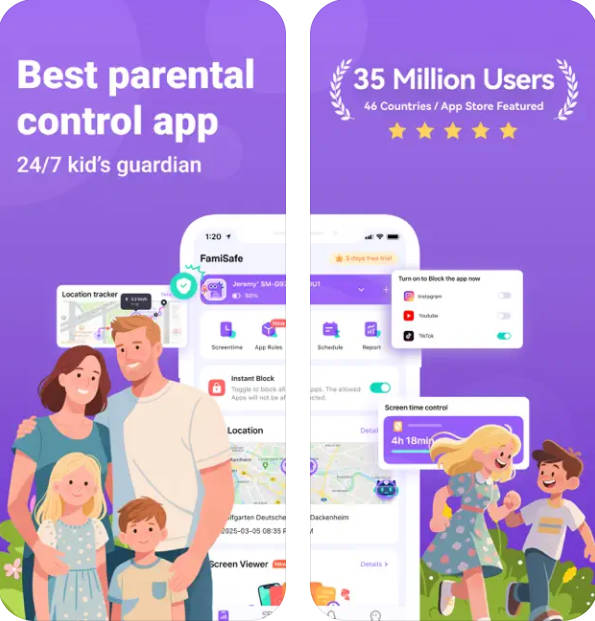5 Effective Solutions to Bullying in School: A Guide for Parents [2025]
Bullying in Schools
ALL TOPICS
- Anti Bullying
- Anti-Bullying Tips
- Parenting Tips
Dec 23, 2025 Filed to: Anti Bullying Proven solutions
Bullying in school remains a persistent challenge for families worldwide, especially as the digital age allows harassment to follow students from the classroom into their homes. As a widespread problem that affects academic performance and mental health, finding effective ways to stop bullying in school is a top priority for proactive parents and educators. By understanding the root causes and implementing strategic prevention measures, we can work together to create a safer environment and minimize the long-term effects of bullying in schools.
In this guide, we’ll explore the most common forms of harassment and provide 5 effective solutions to bullying in school, including how modern technology like FamiSafe can be a powerful ally in early detection.

Key Takeaways
- Early Recognition: Learn to identify the subtle signs of physical, verbal, and cyberbullying.
- Proactive Communication: Establish the "safe harbor" concept at home for honest sharing.
- Smart Tools: Utilize Social Apps Detection to spot emotional risks early.
Table of Contents
Part 1: Types of Bullying – Identifying the Different Masks
To effectively implement school bullying prevention, we must first recognize its different forms. Bullying is rarely one-size-fits-all; it evolves with kids as they age and move between physical and digital spaces.
- Physical Bullying
The most visible form of bullying in school, involving contact that causes injury or damage to property (e.g., hitting, kicking, or damaging school supplies). - Cyberbullying on Social Media
One of the most dangerous long-tail effects of bullying in schools, where harmful content is spread via social apps, making it difficult for the victim to find a safe space outside of school hours. - Verbal Harassment
Consists of name-calling and persistent teasing. While it leaves no physical scars, it's often the precursor to more severe forms of physical bullying in school. - Social Exclusion
Relational aggression where a student is intentionally left out of groups or rumors are spread to damage their reputation within the school community.

Part 2: The Ripple Effect – Consequences of Bullying in Schools
Bullying in school is not just a "phase." It creates a ripple effect of negativity that can alter a child's future. Understanding these consequences is vital for school bullying prevention.
Impact on the Victim
- Mental health issues (depression/anxiety).
- Academic decline and school avoidance.
- Physical symptoms like headaches or insomnia.
Impact on the Bully
- Increased risk of aggressive behavior in adulthood.
- Higher likelihood of substance abuse problems.
- Difficulty maintaining healthy relationships.
The Silent Witnesses: Even bystanders who watch bullying in school occur are affected, often feeling a constant sense of insecurity and powerlessness that impacts their own emotional well-being.
Part 3: 5 Proactive Solutions to Stop Bullying in Schools
Stopping harassment requires a multi-layered approach. Here are the most effective strategies for preventing school bullying today.
Solution #1: Foster Open and Honest Conversations
Trust is the ultimate defense against bullying in school. Encourage your child to share their daily experiences without fear of judgment. Ask specific questions like, "Who did you sit with at lunch today?" to get a clearer picture of their social dynamics.
Solution #2: Build Assertiveness and Survival Skills
Helping your child develop confidence is key to school bullying prevention. Role-play scenarios where they say "Stop" firmly or use humor to deflect a bully's attention. Teach them that staying in a group of friends significantly reduces the risk of being targeted.
Solution #3: Initiate Formal School Intervention
Don't hesitate to contact the administration. Most institutions have strict protocols for bullying in schools. Prepare a log of incidents—dates, locations, and witnesses—to help the school take faster action.
Solution #4: Identify Red Flags at an Early Stage
Parents Tip: Unexplained bruises, torn backpacks, or a sudden drop in grades are major indicators of bullying in school that shouldn't be ignored.
Solution #5: Leverage Advanced Social Safety Tools
Since modern bullying in schools often spills into digital chats, parents need a way to monitor hidden risks on platforms like Snapchat, TikTok, and Instagram.
Part 4: AI Detection – The Modern Front in Bullying Prevention
You can't be at school 24/7, but FamiSafe provides a digital safety net. Its features are tailored to combat the modern complexities of bullying in schools.
FamiSafe's Social Apps Detection offers parent-centric capabilities:
Keywords Alert
Define a list of "red flag" words. If someone sends your child a bullying message using these terms, you get an instant mobile alert.
AI Insights
Beyond words, it analyzes the emotional tone of chats, detecting signs of distress or targeted harassment that might go unnoticed.
Early intervention is the best solution to bullying in school. With FamiSafe, you can identify emotional patterns and intervene before a digital conflict turns into a physical one at school.

Conclusion
Bullying in school is a significant hurdle for any child's development, but it is one you don't have to face alone. By staying involved in their school life, fostering a culture of open communication at home, and using smart tools like FamiSafe to monitor the digital landscape, you can effectively help stop bullying in school and ensure your child feels safe, supported, and ready to learn.
Take Action Against Bullying in Schools Today
Get real-time insights into your child's social environment and physical safety.
Start Protecting Your Child



Thomas Jones
chief Editor